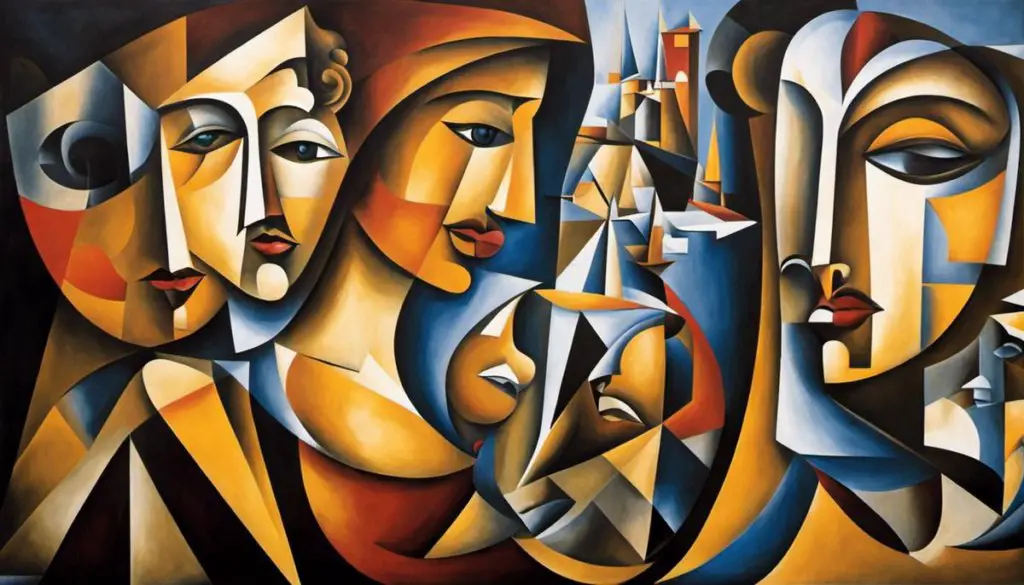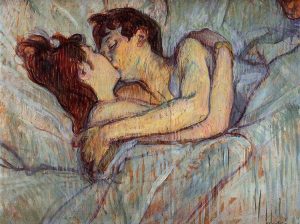In the constantly evolving art world, the Cubist movement, originating in the early 20th century, squarely sits as a pivotal point of this dynamic landscape. Characterised by its radical concept of portraying subjects from various perspectives within a single piece of work, Cubism cemented its mark dislodging traditional norms, as we will delve into the roots and continual transformation of this movement. Furthermore, we will shine a spotlight on the pioneering artists and their seminal contributions to Cubism, namely the virtuosos Pablo Picasso, Georges Braque, Jean Metzinger, and Albert Gleizes. Presenting an in-depth dissection of their signature works, we aim to shed light on their distinct artistic quirks and the lasting imprint they’ve engraved on the face of art.
The Concept and Evolution of Cubism
Unveiling Cubism: Its Evolution and Lasting Impressions on Art
Venturing into the world of art, you are likely to encounter a smorgasbord of movements, each with its own characteristics, mandate, and causes. However, very few invite a deeper analysis of their evolution, influence, and enduring relevance like Cubism. Born of an insatiable desire to delve into and depict reality from multiple angles, Cubism cascades beyond convention, breaking away from traditional single viewpoint perspectives. Let’s embark on a journey through the prism of Cubism, tracing its evolution and its indelible influence on art.
Stepping into the roots of this artistic revolution, we are transported to the early 20th century, specifically between 1907 and 1914. This marked the birth of the ‘Analytical Cubism’ phase. Spearheaded by artists like Pablo Picasso and Georges Braque, this phase hinged upon breaking down objects and reassembling them in an abstract form. Picture a multitude of viewpoints presented simultaneously. Peculiar? Perhaps. Revolutionary? Absolutely!
Breaking away from the density of Analytical Cubism, we encounter a more colourful era around 1912, known as ‘Synthetic Cubism’. A period when artists started to incorporate foreign elements or different materials into their work, creating vivid, collage-like masterpieces. This phase witnessed the birth of noteworthy works such as Picasso’s “Still Life with Chair Caning”, which marked a shift in perception, looking at art beyond the confines of a canvas.
From these origins, Cubism has experienced both distinct evolutions and subtle metamorphoses. Navigating through the years, the ‘Orphic Cubism’ sub-style emerged, intertwining Cubism with vibrant colours and musical qualities. Artists like Robert and Sonia Delaunay took cubist techniques and added a harmonic ensemble of colour, creating pieces that serenade the eyes, akin to music to the ears.
In a greater scope, Cubism evolved to embrace and inspire even the realms of architecture, forcing a change in the approach towards space, structure, and form. Notably, architects like Le Corbusier applied cubist elements, blurring the boundaries between design and art.
As for Cubism’s influence on art, the footprints are unmistakeable. This movement was instrumental in shaping abstract art, throwing forth a pulsating palette of geometric layers and shapes. Traditional representation of subjects turned on its head, paving the path for novel art genres such as Futurism, Constructivism, and Abstract Expressionism.
In the genre of Surrealism too, Cubism’s mark is evident. By dismantling the singular viewpoint, Cubism paved the way for surrealism’s dreamy landscapes filled with frenzied compositions. Artists like Salvador Dalí drew inspiration from the cubist technique of dissecting reality and reassembling it in unexpected ways.
Cubism, since its conception, has been a criterion for redefining perspectives within art. Its evolution traces an intriguing journey of innovation, while its influence perfects the embodiment of a creative revolution. It is a testament to the power of transforming the ordinary into the extraordinary and breaking free from the constraints of conventional viewpoints. This echo of Cubism remains a vibrant thread in the evolving tapestry of art. Through its tonal shifts, aesthetic challenge and innovative techniques, it continues to vibrate through the global art community, reminding us that creativity, perhaps, has more dimensions than one. Crafted not just for the eye, but stimulating the mind and courting the soul – that’s the sensational charm and enduring legacy of Cubism.

Key Figures in Cubist Art
Unlocking the Key Figures of Cubist Art
Across the yesteryears of art history, startlingly blend together like a vivid Cubist collage, there’s no missing the distinctive voices that emerged from the Cubist movement. Within an already exhilarating realm of cubist creativity, certifiably teeming with fractured forms and multidimensional intricacies, several individuals managed to stand out not merely by the brush strokes of their artistry, but through the impactful resonance their vision had.
Meet the Pioneers: Georges Braque and Pablo Picasso
The domino effect of Cubism was set into motion by two audacious personas – Georges Braque and Pablo Picasso. Sharing an evolving friendship and a proclivity towards innovation, Braque and Picasso, by 1908, began embarking on the venture that would shatter perceptions of reality within the artistic sphere.
Rejecting traditional perspective and form, Braque’s works, such as “Viaduct at L’Estaque” and “House at L’Estaque”, showcase an inspired fusion of natural forms with geometric structures. Brush and paint come together, weaving an intricate dance between realism and abstraction. His innovative style echoes through every corner of Cubist art, extending its influence towards the facets of Fauvism and Impressionism.
Following suit, Picasso unveiled his magnum opus, “Les Demoiselles d’Avignon”, in 1907. The piece showcased a striking amalgamation of African art influences with a modernist disregard for traditional perspective and resulted in an evocative dialogue of forms that tilted the scales for visual artists worldwide. Picasso’s innovative interpretations of reality, whether through graceful paint strokes in “Girl with a Mandolin” or textural collage in “Still Life with Chair Caning”, became hallmarks of his enduring legacy in Cubist art.
The Expansive Reach: Fernand Léger and Albert Gleizes
Just as a vibrant canvas brims with juxtaposing shades, so too does the field of Cubist art encompass varied interpretations. Fernand Léger was one such artist who blended the essence of Cubism with his unique aesthetic. Showcasing a thrilling play of geometric accuracy and aesthetically pleasing lines, Léger breathed life into machines and mechanical elements through works such as “The City” and “The Card Players”.
Bridging the gap between innovation and education, Albert Gleizes aimed to make Cubism more accessible to the public. Gleizes contributed significantly to the theoretical aspect of Cubism, co-authoring ‘Du Cubisme’, and his analytical works often portrayed a rhythmic blend of colours and shapes, as seen in “L’Homme au Balcon” and “Le Chemin”.
Though the appetite for exploring Cubist art seems to ever grow in intensity, it’s quintessential to remember that these pioneering figures served as the creative catalysts. For every geometrically challenged tradition and boldly disrupted perspective, there were these artists, their masterful works and their distinct elements fuelling the radical revolution known as Cubism. Through their passion, Cubism was imbued with an enduring streak of creativity, one that remains a cornerstone in the edifice of modern art. Whether one is an ardent art lover, a creator, or an intrigued bystander, delving into the bedrock of Cubism and the artists who shaped it is undoubtedly a vibrant journey of exploration and understanding.

Cubism and its Lasting Impact on Modern Art
The journey through the world of art can lead us down many fascinating paths. Cubism, a groundbreaking art movement encompassing the early 20th century, is one such intriguing path that requires us to shift our perspective. Emerging as a radical departure from the traditional single perspective views, it offered a new way of interpreting the world by presenting a multifaceted view of objects on canvas.
The maestros of this creative uprising were Georges Braque and Pablo Picasso, who played pivotal roles in broadening the horizons of visual representation on canvas. The incredible depth of their innovations, intensified by their groundbreaking techniques, marked the genesis of a revolutionary chapter in the history of art.
Braque’s artistry was a blend of innovation and dissolution. His approach to Cubism combined a variety of textures, from hard to soft, and carved out an intimate space of sensory reflection. On the other hand, Picasso, not only disrupted the pre-established norms of artistic expression but also influenced subsequent generations with his profound technical versatility.
Another noteworthy Cubist to have left an indelible mark on art history is Fernand Léger. This veteran’s unique interpretation borrowed heavily from themes of industrial technology, expressing the rhythm of the mechanised world through his canvases. His art did not confine itself to pure geometric abstraction but celebrated human form, asserting a paradoxical warmth amidst his mechanical aesthetics.
Albert Gleizes provided not just a visual demonstration of Cubism, but also contributed to its theoretical understanding. His vivid manifestation of geometric patterns was married with a strong theoretical construct, helping cement Cubism as an intellectual movement.
The permeation of Cubism into various fields of art testifies to its enduring legacy and undeniable influence on modern art. Be it the stark austerity of minimalist art, the emotional immersion of installations, or the daring experimentation of digital art, the innovative spirit of Cubism pervades. Furthermore, the theoretical foundations fostered by artists such as Gleizes paved the way for academics to delve into new realms of understanding, thus broadening the scope of study in modern art history.
In conclusion, the impact and influence of Cubism continue to reverberate across the international art community, shaping it into a thriving, eclectic hub of creative energy. Just as the Cubists dissolved the boundaries of two-dimensional artistry, modern artists imbued with the Cubist spirit continue to push past the norms, etching their unique imprints on the wide canvas of the contemporary art world. The potent blend of innovation, abstraction, and creation that Cubism offered continues to be a powerful magnet, drawing in artists from all walks of life and propelling the evolution of art.

The magnitude of Cubism’s influence on the art world is monumentally evident throughout the prism of art history and beyond. Futurism, Constructivism, and Orphism, among others, bear the artistic nuances introduced by the Cubist revolution. Simultaneously, the shockwaves of this movement’s impact can be inherently felt across the diverse spread of modern-day design practices – from avant-garde fashion runways to contemporary interior settings and the digital canvas of graphic artistry. Truly, the legacy of the Cubist era still echoes within the vibrant art scene of the present day, underscoring the endurance of its revolutionary approach.
Recommend0 recommendationsPublished in Art Movements




Responses